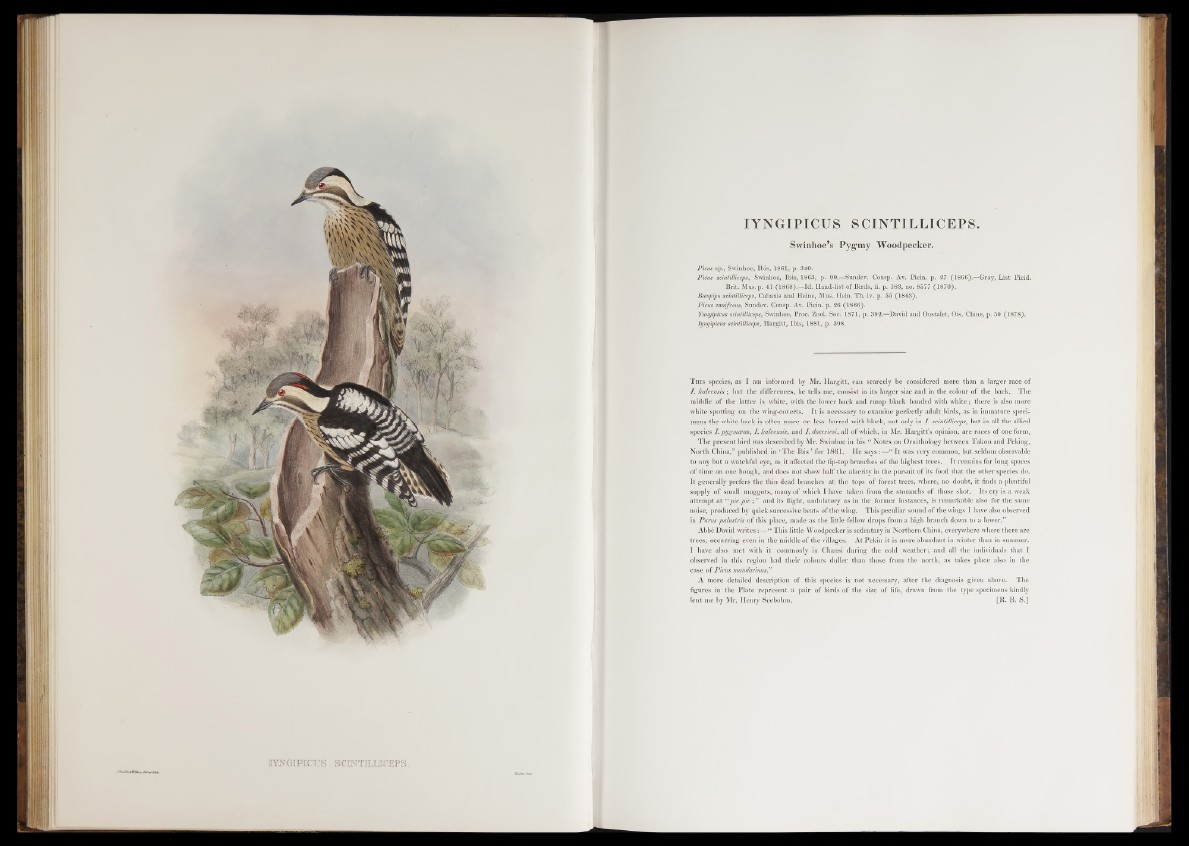
iXàn&l'ArJZ&B-q t&Ze&7r£A/.
■ W B S CTHTQIXICEPS.
IYNGIPICUS SCINTILLICEPS.
Swinhoe’s Pygmy Woodpecker.
Picus sp., Swinhoe, Ibis, 1861, p. 340.
Picus sdntilliceps, Swinhoe, Ibis, 1863, p. 90.—Sundev. Consp. Av. Picin. p. 27 (1866).—Gray, List Picid.
Brit. Mus. p. 41 (18 6 8 ).—Id. Hand-list of Birds, ii. p. 183, no. 8577 (1870).
jBaopipo sdntilliceps, Cabanis and Heine, Mus. Hein. Th. iv. p. 55 (1863).
Picus canifrons, Sundev. Consp. Av. Picin. p. 26 (1866).
Yungipicus sdntilliceps, Swinhoe, Proc. Zool. Soc. 1871, p. 392.—David and Oustalet, Ois. Chine, p. 50 (1878).
Iyngipicus sdntilliceps, Hargitt, Ibis, 1881, p. 398.
T h is species, as I am informed by Mr. Hargitt, can scarcely be considered more than a larger race of
I . kaleensis ; but the differences, he tells me, consist in its larger size and in the colour o f the back. The
middle of the latter is white, with the lower back and rump black banded with white ; there is also more
white spotting on the wing-coverts. It is necessary to examine perfectly adult birds, as in immature specimens
the white back is often more or less barred with black, not only in / . sdntilliceps, but in all the allied
species / . pygmceus, I. kaleensis, and I. doerriesi, all o f which, in Mr. Hargitt’s opinion, are races of one form.
The present bird was described by Mr. Swinhoe in his “ Notes on Ornithology between Takoo and Peking,
North China,” published in ‘ The Ibis ’ for 1861. He says “ It was very common, but seldom observable
to any but a watchful eye, as it affected the tip-top branches of the highest trees. It remains for long spaces
o f time on one bough, and does not show half the alacritv in the pursuit o f its food that the other species do.
It generally prefers the thin dead branches at the tops o f forest trees, where, no doubt, it finds a plentiful
supply o f small maggots, many of which I have taken from the stomachs of those shot. Its cry is a weak
attempt at “pic p i c audits flight, undiilatory as in the former instances, is remarkable also for the same
noise, produced by quick successive beats of the wing. This peculiar sound of the wings I have also observed
in Pams palustris of this place, made as the little fellow drops from a high branch down to a lower.”
Abbé David writes :— “ This little Woodpecker is sedentary in Northern China, everywhere where there are
trees, occurring even in the middle of the villages. At Pekin it is more abundant in winter than in summer.
I have also met with it commonly in Chansi during the cold weather; and all the individuals that I
observed in this region had their colours duller than those from the north, as takes place also in the
case of Picus tnandarinus.”
A more detailed description of this species is not necessary, after the diagnosis given above. The
figures in the Plate represent a pair of birds of the size of life, drawn from the type specimens kindly
lent me by Mr. Henry Seebohm, [R. B. S.]